Boost KS1 Reading Fluency with Interactive, Multi-Sensory Strategies
Introduction: The Importance of Reading Fluency in KS1
Reading fluency is a vital component of literacy development in Key Stage 1, setting the stage for a child's broader academic journey. It enables pupils to recognise words efficiently and with expression, which is essential for meaningful comprehension. This blog post will explore how reading fluency can be enhanced within the classroom, echoing our belief that a focused approach can 'improve your classroom's literacy results, almost overnight!'
At its core, reading fluency is about the seamless interplay between accuracy, speed, and comprehension. The ability to read smoothly influences how children understand and engage with texts, forming the foundation of effective learning. Recognising the impact of these skills helps teachers to create a classroom environment where every pupil is supported and nurtured. 
This article is structured to guide teachers through innovative strategies and practical methods that are proven to boost reading fluency in KS1. Readers will gain insights into multi-sensory approaches and hands-on activities, as well as learn how to utilise interactive resources such as the Mighty Writer mat. The aim is to provide both a theoretical understanding and actionable steps to enhance literacy outcomes in every classroom.
Understanding KS1 Reading Fluency: Challenges and Opportunities
Many teachers face challenges when developing reading fluency in KS1, as pupils often struggle with consistency and the confidence to read aloud. Variations in ability, limited time, and a shortage of engaging resources can all contribute to these difficulties. However, these challenges also open opportunities to innovate and adapt teaching methods to meet diverse pupil needs.
By incorporating multi-sensory approaches and engaging activities, educators can transform these challenges into chances for significant improvement. Such strategies help in bridging the gap between reading and comprehension, making learning more interactive. With methods designed to 'make writing fun and engaging,' even the most reluctant readers can find their voice.
Practical Strategies to Boost Reading Fluency
Consistent practice through techniques like choral reading and echo reading can significantly enhance a child's reading fluency. These strategies embed a rhythm and familiarity with language that helps pupils internalise words and phrases. 
In addition, creative classroom activities such as paired reading and role-playing exercises further reinforce fluency by placing children in dynamic and supportive learning scenarios. Such approaches not only improve accuracy and speed but also inspire children to enjoy the process of learning, enabling them to 'boost literacy results' effectively.
Engaging Hands-on Activities for KS1 Pupils
Hands-on activities form an essential part of maintaining engagement in young learners while enhancing their reading fluency. By incorporating tactile learning experiences, such as sentence assembly games and interactive story sessions, children can better connect with the material. These activities are specifically designed to stimulate interest and prompt active learning, ensuring that children remain involved and encouraged.
For example, tasks that involve arranging colourful image tiles to form sentences mimic the practical approach of the Mighty Writer resource. This not only makes the activity enjoyable but also reinforces the skills necessary for fluent reading, bridging practical learning with academic achievement.
Integrating Multi-Sensory Approaches
Multi-sensory learning ensures that visual, auditory, and kinaesthetic elements are all engaged in the process of reading. Such techniques allow teachers to cater to different learning styles, ensuring that each pupil gains from the activity. This approach helps in bolstering comprehension, as pupils are exposed to texts through various senses simultaneously.
Examples of multi-sensory activities include using sound clips accompanied by visual cues and physical movement exercises that relate to the text. These integrative methods enable a more robust understanding and retention of language skills, aligning perfectly with the philosophy of making literacy both interactive and accessible.
Using Interactive Resources: The Mighty Writer Mat
Mighty Writer is a unique interactive resource designed to engage children through its colourful image tiles, sentence clouds, and velcro symbols. Its interactive nature encourages pupils to physically arrange and construct sentences, which reinforces both reading and writing skills in an enjoyable manner.
This resource supports learning by transforming abstract concepts into tangible activities, making sentence construction a hands-on experience. As a tool that aims to 'make writing fun and engaging,' it empowers teachers to create a classroom environment where literacy skills are developed naturally through play.
Developing Structured and Supportive Lesson Plans
Structured lesson plans play a critical role in achieving literacy goals as they provide a clear, consistent framework for teaching. With well-defined objectives and regular reading exercises, educators can systematically build up each pupils reading fluency over time.
Practical tips include embedding reading exercises into daily routines and utilising CPD training sessions to ensure teachers are well-equipped with the latest strategies. By using resources such as the Mighty Writer teacher's guide, which offers detailed lesson plans and reviews, teachers can enhance their classroom practice and drive sustained improvement.
Creating an Inclusive and Encouraging Classroom Environment
Building an inclusive classroom is essential in nurturing every child's self-esteem and engagement with literacy activities. Teachers can foster inclusivity by celebrating diverse learning abilities and ensuring that every pupil feels supported in their journey toward improved reading fluency.
Encouraging collaborative activities and peer support initiatives helps create a community of learners where every voice is valued. These strategies not only address individual needs but also contribute to a collective classroom spirit where learning is both supportive and transformative.
Complementing Reading with Creative Writing Tasks
Complementing reading exercises with creative writing tasks reinforces fluency by encouraging pupils to express and expand upon what they have read. Engaging in creative writing helps solidify vocabulary and comprehension skills while offering a playful outlet for imagination. 
For instance, tasks that encourage pupils to craft alternative story endings or to depict scenes from their favourite stories can bolster both reading and writing skills. This integrated approach nurtures a more holistic literacy development, ensuring that learning remains both creative and effective.
